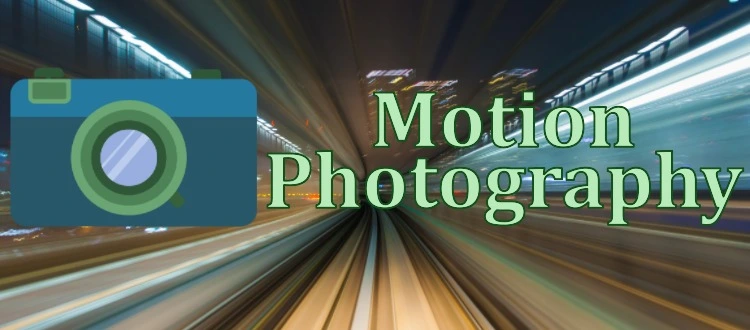Theodore Lowe, Ap #867-859
Sit Rd, Azusa New York
Find us here
A Beginner's Guide to Motion Photography

Motion photography can be both challenging and rewarding. Beginners often struggle with capturing the perfect shot that conveys movement. This guide aims to simplify the process. Start by understanding your camera settings, such as shutter speed and ISO. Use a fast shutter speed to freeze motion or a slow one to blur it.
Experiment with different angles and compositions. Practice panning to follow moving subjects smoothly. Invest in a tripod for stability. Study the work of experienced photographers for inspiration. With patience and practice, you can master the art of motion photography and create stunning, dynamic images.
Essential Gear
Getting started with motion photography requires the right equipment. The right gear helps you capture stunning motion shots. Let's explore the essential tools you'll need.
Choosing The Right Camera
Picking the right camera is crucial for motion photography. DSLR cameras are a popular choice. They offer excellent control and image quality. Mirrorless cameras are also a great option. They are lighter and have faster autofocus.
Ensure your camera has a high frame rate. A high frame rate helps capture fast-moving subjects. Look for a camera with good ISO performance. This helps in low-light conditions.
Lenses For Motion Photography
Lenses play a key role in motion photography. A fast lens with a wide aperture is essential. It allows more light and creates a beautiful bokeh effect.
Consider using a zoom lens. It provides flexibility to capture subjects at different distances. Prime lenses are also great. They offer sharp images and wide apertures.
Here is a quick comparison of lens types:
|
Lens Type |
Features |
Best For |
|---|---|---|
|
Zoom Lens |
Flexible, varied focal lengths |
Sports, Wildlife |
|
Prime Lens |
Sharp images, wide apertures |
Portraits, Low-light |
Remember to use the right gear to capture amazing motion shots. Happy shooting!
Camera Settings
Capturing motion requires understanding your camera settings. These settings will help you freeze or blur motion. Knowing how to adjust them is key to great motion photography.
Shutter Speed Basics
Shutter speed controls how long the camera's sensor is exposed to light. It affects motion blur. A fast shutter speed like 1/1000s will freeze motion. A slow shutter speed like 1/30s will create motion blur.
Use a fast shutter speed to capture sharp images of moving subjects. Use a slow shutter speed to show motion blur, like car lights at night.
|
Shutter Speed |
Effect |
|---|---|
|
1/1000s |
Freezes fast-moving subjects |
|
1/30s |
Creates motion blur |
Aperture And Iso
Aperture controls the amount of light entering the lens. It also affects depth of field. A wide aperture (f/2.8) lets in more light and creates a blurry background. A narrow aperture (f/16) lets in less light and keeps more of the scene in focus.
ISO controls the camera's sensitivity to light. A low ISO (100) is good for bright conditions. A high ISO (3200) is better for low light but can add noise.
-
Wide Aperture (f/2.8): More light, shallow depth of field
-
Narrow Aperture (f/16): Less light, deep depth of field
-
Low ISO (100): Less noise, good for bright light
-
High ISO (3200): More noise, good for low light
Balancing shutter speed, aperture, and ISO is essential. Experiment with these settings to master motion photography.
Techniques For Capturing Motion
Capturing motion in photography can be thrilling. It brings your photos to life. To master this, you need to learn some key techniques. Here, we will explore two popular methods: Panning and Freeze Motion.
Panning Technique
The panning technique helps show motion in your photos. You focus on a moving subject. The goal is to keep the subject sharp while the background blurs. This creates a sense of speed.
Follow these steps to perfect panning:
-
Set your camera to Shutter Priority Mode or Manual Mode.
-
Choose a slow shutter speed, like 1/30 or 1/60.
-
Focus on the subject and move the camera with it.
-
Press the shutter while still moving the camera.
Practice this technique to get smoother results. Your subject should be sharp, while the background shows motion blur.
Freeze Motion Technique
The freeze motion technique captures a split second of action. This makes the moving subject appear still. It is great for fast-paced scenes.
Follow these steps to freeze motion:
-
Set your camera to a fast shutter speed, like 1/1000 or higher.
-
Use Continuous Shooting Mode for better results.
-
Focus on the moving subject.
-
Press the shutter button to capture multiple shots.
This technique works well with sports, wildlife, and fast action scenes. The subject appears crisp and clear.
Understanding these techniques will enhance your motion photography skills. Experiment with both methods to see what works best for you.
Lighting Tips
Lighting is crucial in motion photography. It affects the mood and clarity of your images. Understanding how to use light can make your photos stand out. Here are some helpful lighting tips for beginners.
Using Natural Light
Natural light is free and versatile. It can create stunning effects. Use the golden hour for soft, warm light. This is the hour after sunrise and before sunset.
-
Midday sun: Avoid harsh shadows by shooting in the shade.
-
Overcast days: Clouds act as a natural diffuser, giving even light.
-
Reflections: Use water, glass, or mirrors to bounce light onto your subject.
Position your subject with their back to the sun. This creates a beautiful halo effect. Use a reflector to fill in shadows.
Artificial Lighting Options
Artificial lighting gives you control over your scene. You can shoot at any time and adjust the light as needed.
|
Type |
Benefits |
Drawbacks |
|---|---|---|
|
Continuous Light |
Easy to see effects instantly |
Can get hot |
|
Speedlights |
Portable and affordable |
Shorter battery life |
|
Studio Strobes |
Powerful and versatile |
Expensive and bulky |
For beginners, speedlights are a great choice. They are easy to use and budget-friendly. Place them at different angles to create depth and interest.
-
Set up your light source. Position it to the side of your subject.
-
Adjust the power. Start low and increase as needed.
-
Use modifiers. Softboxes and umbrellas diffuse light for a softer look.
Experiment with different lighting setups. Practice will help you understand how light affects your photos.
Composition Strategies
Capture motion in photography requires understanding composition strategies. These strategies help create dynamic and engaging photos. This section covers important techniques to enhance your motion photography skills.
Rule Of Thirds
The Rule of Thirds is a fundamental composition technique. Divide your frame into nine equal parts. Use two horizontal and two vertical lines.
|
Benefits |
Details |
|---|---|
|
Balance |
Creates a balanced photo. |
|
Focus |
Draws attention to the subject. |
Place your subject at the intersection points. This makes the photo visually appealing. For motion shots, place the moving subject along these lines.
Leading Lines
Leading lines guide the viewer's eyes through the photo. These lines can be roads, rivers, or paths.
-
Use natural lines like rivers.
-
Use man-made lines like roads.
Position leading lines to direct focus toward the subject. This adds depth and movement to your photo. It keeps the viewer engaged.
Experiment with different angles. Find the most effective way to capture motion. Mastering these strategies will elevate your motion photography.
Common Mistakes
Starting with motion photography can be exciting. Yet, beginners often make avoidable mistakes. Identifying and fixing these common errors can improve your photos significantly.
Blurry Images
Blurry images are a frequent issue. This usually happens due to camera shake or incorrect focus. To avoid this, use a tripod for stability. A tripod keeps the camera steady. Also, ensure your subject is in focus. Use the autofocus feature for better results. Fast shutter speeds help capture crisp motion. A speed of 1/500th of a second or faster is ideal. Additionally, consider using burst mode. This mode captures several shots in quick succession. One of them is likely to be sharp.
Overexposure And Underexposure
Light balance is crucial in motion photography. Overexposure makes photos too bright. Underexposure makes them too dark. Use the camera's light meter to check exposure levels. Adjust the aperture to control light entering the lens. A smaller aperture (higher f-stop number) reduces light. A larger aperture (lower f-stop number) allows more light. Here’s a quick reference:
|
Exposure Issue |
Solution |
|---|---|
|
Overexposure |
Reduce ISO, use a smaller aperture, or faster shutter speed. |
|
Underexposure |
Increase ISO, use a larger aperture, or slower shutter speed. |
ISO settings also play a role. Higher ISO can brighten images but may add noise. Find a balance for the best results. Experiment with different settings. Practice helps you learn quickly.
Practice And Improvement
Becoming proficient in motion photography requires consistent practice and a keen eye. It's essential to dedicate time to practice and analyze your work. This helps you improve your skills and develop a unique style.
Daily Practice Tips
-
Set a Schedule: Dedicate 15-30 minutes daily to practice.
-
Experiment: Try different subjects, settings, and techniques.
-
Use a Tripod: It helps stabilize your camera for clear shots.
-
Adjust Shutter Speed: Play with various shutter speeds for different effects.
-
Review Settings: Note the camera settings for each shot.
-
Capture in Burst Mode: Take multiple shots to get the perfect one.
Analyzing Your Work
After capturing motion, it's crucial to analyze your photos. This helps identify areas of improvement and understand what works best.
-
Review Your Shots: Look at each photo critically.
-
Check Sharpness: Ensure your subject is in focus.
-
Evaluate Composition: See if the composition draws attention.
-
Note Lighting: Observe how light affects the motion.
-
Seek Feedback: Share your photos with others for constructive criticism.
Keeping a journal of your practice sessions can be helpful. Record the settings, conditions, and outcomes of each session. This helps track your progress and identify patterns in your work.
|
Aspect |
Questions to Ask |
|---|---|
|
Sharpness |
Is the subject clear and in focus? |
|
Composition |
Does the composition enhance the motion? |
|
Lighting |
Is the lighting appropriate for the scene? |
|
Settings |
Were the camera settings optimal? |
Conclusion
Mastering motion photography requires practice and patience. Experiment with different techniques and settings. Embrace the learning process. Capture the magic of movement. Soon, you'll create stunning, dynamic images. Keep your camera ready and seize every moment.
Related blog posts
The Pros And Cons of Using 3D Mockups Vs. Ghost Mannequin
When you're in the business of selling products online, the way your items are presented can make or break a sale. You've got two powerful tools at your disposal: 3D mockups and ghost mannequin photography.


